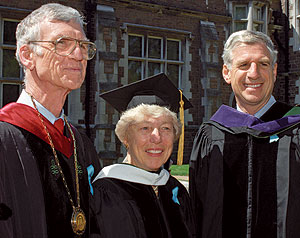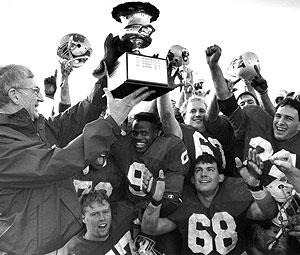In 1997 — fully 70 years after its inception — the Danforth Foundation took a bold step.
The trustees analyzed the foundation priorities and noted that the St. Louis region faced many critical quality-of-life issues and problems in the areas of economic viability, housing, health and the environment, physical infrastructure and education.

They believed the foundation could have the greatest impact if it concentrated its resources exclusively on the St. Louis metro area.
So, on May 31, 1997, based on the recommendation of trustees and members of the corporation, the Danforth Foundation ceased to be a national foundation.
And St. Louis benefited. The foundation broadened the focus of its regional philanthropy to include important civic and community projects, as well as education.
One of the results of this redirection of priorities was the $100,000 “I Dare You” award to challenge the metro St. Louis community to create a “religious renaissance.” Over a four-year period, the award recognized a religious congregation for its community outreach efforts to the poor, homeless, elderly and youth.
The Central Reform Congregation received the 2000 “I Dare You” award.
“Even more than the money, it was a challenge to continue the legacy of ‘I Dare You,’ the Danforth brothers’ grandfather’s little red book of how to live,” says Susan Talve, senior rabbi at Central Reform Congregation. “I buy the book and give them out all the time. Its message inspires individuals and institutions and communities and maybe even nations to act reasonably and become part of a community to make a more loving world.”
Those words pretty well sum up the first William H. Danforth (1870-1955) and how he lived his life.
After graduating from the Manual Training School and Washington University, Danforth founded — at age 24 — a horse and mule feed company, the Robinson-Danforth Co., based on the idea that farmers would welcome an opportunity to purchase prepared animal feed.
A month later, a tornado demolished the company.
Danforth then assumed leadership, put all of his remaining resources on the line and rebuilt the enterprise. The company prospered, and by the mid-20th century had grown into an international corporate giant in the animal and pet food business — the Ralston Purina Co.
Then, in 1927, Danforth founded an organization that had as big an impact as the feed store, but in a completely different field. He, his wife Adda, son Donald and daughter Dorothy established the Danforth Foundation “for charitable and humanitarian purposes and to promote the well-being of mankind.” He wanted to help people be at their “very best, all the time.”
The plan was to encourage young people to excel in all aspects of their lives, especially education. In this way, the Danforths believed youth would reach their highest potential, and as a consequence, the United States and the world would be improved.
Through it all, education was at the forefront of the Danforth Foundation’s goals, gifts and grants.
When the foundation was first established, the initial programs and grants were to help young people from around the United States develop the “Four Square” (physical, mental, social and spiritual) traits promoted by Danforth in his book, in his approach to business and in his philanthropic ideology.
This started almost immediately when in 1929 the foundation sponsored Summer Fellowship Awards to students at approximately 25 state agricultural colleges to “assist [them] in obtaining a closer view of business, widening their horizons, and assisting them in making a choice of their life’s work upon leaving college.”
Initiating first program

Several yearly awards, grants and scholarships followed, and then in 1941, the foundation established its first program — the Danforth Associates Program — to improve the quality of teaching and learning on university campuses. The program was developed to improve personal communication between teacher and students.
“Donald Danforth, (William H. Danforth’s son), took the company that his father had founded and really built a successful business in the 1940s, ’50s and ’60s that funded the foundation,” said John Biggs, a member of the Washington University Board of Trustees and head of its investment committee. He also sits on the board of the Danforth Foundation and serves as the head of that investment committee as well.
“And the children! Somehow around that family dinner table (Donald) created such a sense of public duty, ambition and goals that have marked that remarkable family — four terrific children — Bill, Jack, Dorothy and the late Donald Jr., who died of Lou Gehrig’s disease. Bill and Jack are among the Great Americans of their generation. Two in one family.”
In 1952, the foundation initiated the Danforth Graduate Fellowship Program, to “bring into college teaching a larger number of young men, thoroughly trained according to the highest scholastic standards, who are aware of the place for moral and religious values in teaching and counseling … The candidates may be preparing to teach in any academic discipline common to an undergraduate college.”
Approximately 100 scholarships were to be awarded annually under this program.
In 1955, the foundation established Danforth Teacher Grants to provide graduate fellowships for young teachers of outstanding abilities who had not yet completed a doctoral degree.
Just four years later, the foundation made great strides in having an international presence. In 1959, the trustees agreed that grant awards could be made outside the United States.
The Danforth Indian Program was inaugurated, which provided graduate fellowships for teachers in Indian private colleges of liberal arts and sciences.
The selection of India was related to the missionary work of Ruth Seabury, who served as a longtime adviser to the Danforth Foundation on many of the programs it created to enhance religion on college campuses.
That same year saw the first unrestricted grants awarded to individual institutions — the foundation awarded a $300,000 grant to Washington University and a $150,000 grant to Saint Louis University.
Change of focus
The 1960s saw a slight change of focus, based on the changes throughout the nation. Issues in education, health care, housing and racial disparities were at the forefront of the nightly news. In response, the foundation earmarked urban affairs as an important area in which it would undertake grantmaking.
The foundation supported projects such as regional housing conferences, neighborhood coalitions, minority business expositions and community clinics.
Later that decade, staff and trustees decided to concentrate foundation efforts in urban affairs on educational and professional growth opportunities for urban leaders as a means of better targeting resources.
As such, the foundation reaffirmed its commitment to “people and values” and maintained its focus on higher education, supporting selected students in graduate studies through the Danforth Graduate Fellowship Program, the Kent Fellowships and the Graduate Fellowships for Women — the latter two of which were folded into the Danforth Graduate Fellowship Program in 1975.
“Certainly the whole Danforth family has been a role model for service for us all,” says John F. McDonnell, former chairman and current vice chairman of the Washington University Board of Trustees. “All of them individually are role models of service and selflessness.”
Washington University and Saint Louis University were again beneficiaries of the foundation’s support in 1973, when endowment grants were awarded to both: Washington University received $60 million over five years, while Saint Louis University received $20 million.
The grants required that dollar-for-dollar matching funds be raised by each institution.
Parents as Teachers
In 1981, the foundation provided initial support for the Parents as Teachers program, in which parents were recognized as the first and most important teachers of their children and were provided with parent education services.
By the end of the decade, the program was offered in more than 500 Missouri school districts.

Also in 1981, the trustees established the Dorothy Danforth Compton Minority Fellowship Program to provide financial assistance and other support for minority graduate students in the arts and sciences who aspired to be college teachers.
Ten major universities were awarded grants of $105,000 each by the foundation to establish the project.
In the mid-1980s, the foundation proferred several challenge grants to Washington University: $45 million in 1982; $100 million and $55 million in 1986.
Throughout the 1980s and early 1990s, the foundation continued its commitment to public education, bestowing 18 different grants upon the St. Louis Public Schools in 1983 and starting the Danforth Program for the Preparation of School Principals to assist selected colleges and universities in developing new, innovative programs to prepare prospective principals.
By the end of the decade, 22 school district/university partnerships had been established across the United States.
And then came the switch from a global scope to a regional one.
In 1998, a $100 million grant was awarded to Washington University as part of the Campaign for Washington University. In addition to supporting and building upon the region’s well-known strength in medicine and the biological sciences, this gift is also contributing to the further development in the humanities, the social sciences, undergraduate student life, engineering and the University’s partnerships with community organizations.
“No single source of financial support for Washington University has been more important than the Danforth Foundation,” Chancellor Mark S. Wrighton said. “The gifts provided have been placed in the endowment, contributing to the underlying financial strength of the University.
“But the importance of the support is seen in the facilities and programs of the University, and most importantly in the students and faculty supported.
“The foundation support has yielded enormous benefits for our region by advancing education and research that has built economic strength, and the foundation’s support has made it possible to attract many talented and creative leaders to St. Louis.”
Also out of the refocusing of priorities came the Donald Danforth Plant Science Center in 1998, featuring a unique and innovative alliance joining the Danforth Center in collaborative research with the University of Illinois at Urbana-Champaign, the Missouri Botanical Garden, the University of Missouri-Columbia, Monsanto Co., Purdue University and Washington University.
The Donald Danforth Plant Science Center is a not-for-profit research institute with a global vision to improve the human condition.
Research at the Danforth Center is aimed at enhancing the nutritional content of plants to improve human health, increase agricultural production to create a sustainable food supply and provide the scientific advancements and technologies that will contribute to the economic growth of the St. Louis region and of the state of Missouri.
In 2000, the foundation’s trustees identified three specific areas of focus to further define grant-making activities — plant and life sciences, neighborhood redevelopment and downtown St. Louis.
At the time of its 75th anniversary in 2002, the Danforth Foundation had awarded just under $1 billion nationally to 60 programs.
In 2003, the Board of Trustees agreed to dedicate 60 percent of the foundation’s uncommitted assets to the goal of making the St. Louis region a leader in the plant and life sciences.
In 2005, at the request of St. Louis Mayor Francis Slay, the foundation began to assess the possibilities for revitalizing the city’s riverfront and developing a better connection between the Arch grounds and downtown St. Louis.